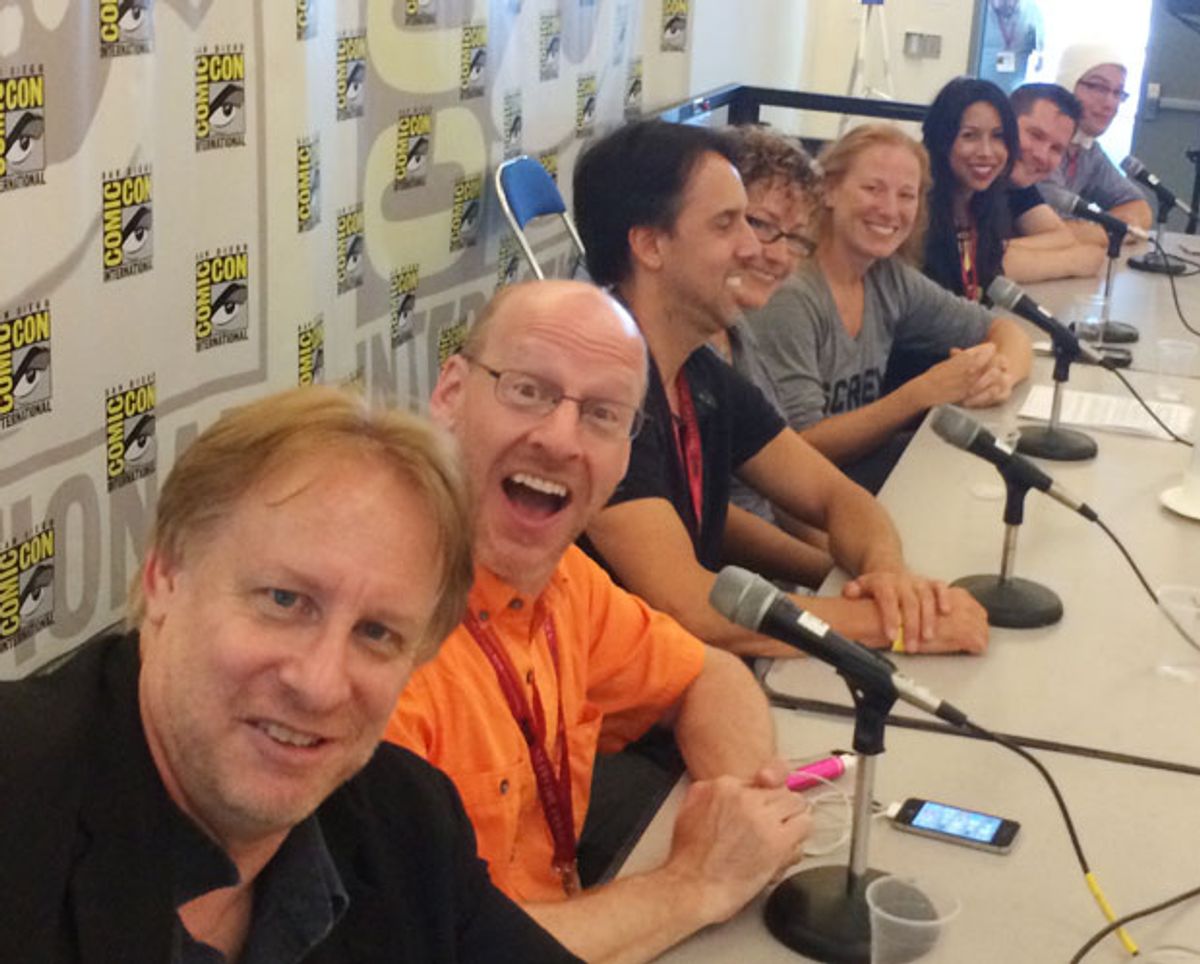The San Diego Comic-Con was last weekend: the convention is the highlight of the pop culture calendar: about 130,000 attendees flock to southern California to check out science fiction and fantasy productions ranging from big upcoming studio movie blockbusters to hand-made comic books from independent artists.
I was there to help promote IEEE Spectrum’s upcoming science fiction anthology Coming Soon Enough e-book (it will be available in the first week of August, but you can get a sneak peek now at a story from award-winning author Nancy Kress), and to moderate a panel of Hollywood writers, producers, and science advisors about some of the issues involved with portraying science and technology in science fiction.
The panelists were Jessica Cail, a neuroscientist at Pepperdine University and a science consultant; Kevin Grazier*, a former JPL mission scientist and consultant to productions such as Battlestar Galactica, Defiance, and Gravity; Andrea Letamendi, a clinical psychologist and creator of Under The Mask, a website devoted to providing insights into superheroes, villains, and their fans; Jaime Paglia, the co-creator of Eureka and currently a producer and writer for upcoming superhero TV show The Flash; Nicole Perlman, co-writer of the movie Guardians of the Galaxy; Phil Plait, the science communicator behind the Bad Astronomy blog; and the writing and producing team of Ashley Miller and Zack Stentz, whose credits include Fringe, X-Men: First Class, and a new, as-yet-untitled, TV series that’s part of the Terminator franchise.
Speaking to a standing-room-only crowd of over 500, the panel was focused on discussing how the representation of scientists and engineers has evolved in recent years. While the stereotype of the scientist as a white male awkward nerd, Einstein-esque saint, or super villain is still around (and alienating to female and minority viewers possibly interested in pursuing STEM careers), newer characters such as Stargate’s Samantha Carter, Eureka’s Allison Blake, and even Fringe’s resident “mad scientist” Walter Bishop are complex, humanized figures. The reasons for this evolution are, in part, due to the larger presence of science advisors in TV and movie productions, facilitated with programs such as the National Academy of Sciences’ Science and Entertainment Exchange, which connect scientists with writers looking for answers to technical questions.
Another reason given by writers and producers on the panel is that an increasing number of writers are becoming aware of the dramatic possibilities inherent in a character struggling with a scientific or engineering challenge. Screenplays which have been able to mine this drama well have thus been able to offer something fresh to audiences weary of stereotyped characters. This translates to a competitive advantage during a period that has been dubbed “the golden age of television,” due to the advent of high-quality, highly serialized shows such as Mad Men, Game of Thrones, Breaking Bad, The Walking Dead and Battlestar Galactica.
Other panels and the exhibition floor at the San Diego Comic-Con also provided a chance to see how new technologies are beginning to filter into popular entertainment. A number of media companies, including Fox Studios and Warner Brothers, offered attendees the chance to wear prototype Oculus Rift virtual reality headsets that immersed them in environments such Professor X’s Cerebro device from the X-Men franchise or a dangerous storm from the yet-to-be released movie Into The Storm. At the booth of special effects house Weta, which has already begun using 3-D printing to create movie props, 3-D printing company 3DS Systems was promoting its technology, including its customized Star Trek figure service (which will allow a customer to put his or her own face on an action figure) that it announced at the Consumer Electronics Show earlier this year. Meanwhile, the impact of new production technologies in comics was an object of existential debate: if a creator starts using digital enhancements to create moving or animated elements, at what point does a comic book stop being a comic book and starts being a jerkily animated cartoon?
But perhaps my favorite thing at Comic Con was an example of how deeply a certain Serbian inventor has wormed his way into popular culture: a comic book from Red Giant Entertainment devoted to the fictionalized adventures of international superhero Nikola Tesla.
Follow Stephen Cass on Twitter: @stephencass
*Disclosure: Kevin Grazier and I are co-authors on an upcoming book called Hollyweird Science.
Photos: Stephen Cass
Stephen Cass is the special projects editor at IEEE Spectrum. He currently helms Spectrum's Hands On column, and is also responsible for interactive projects such as the Top Programming Languages app. He has a bachelor's degree in experimental physics from Trinity College Dublin.




